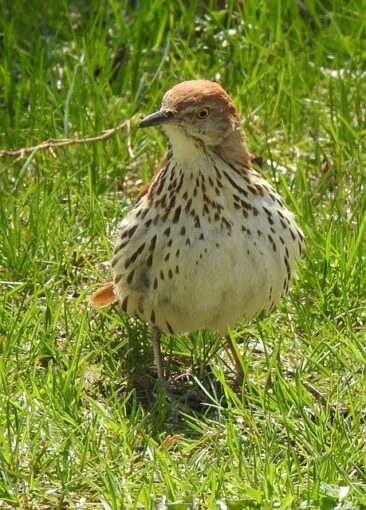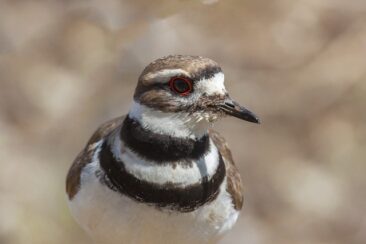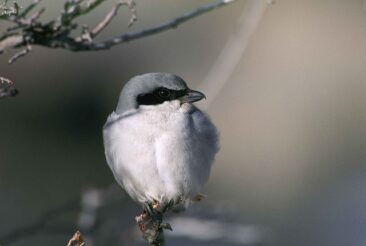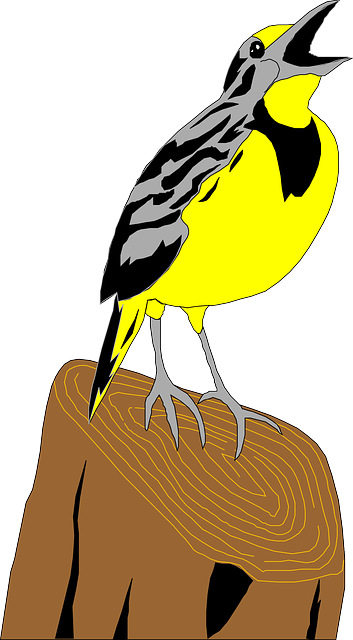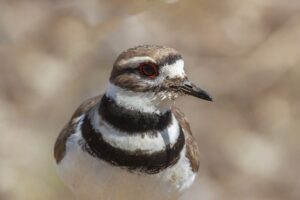
Greetings, readers. Today we find out which birds have evacuated the premises, as we continue our series, Caring for Mother Nature, by my friend, author and naturalist, Peggy Sias Lantz (click her name to visit her website).
Birds I No Longer See
by Peggy Lantz
I’ve been coming to Lake Lucy, where I live now, since I was born. This is where my father grew up and his parents lived and where we always came on vacations.
When I was a teenager visiting my grandparents, I saw several birds that are no longer here. I was a young birdwatcher even then, and I could identify Killdeer, Eastern Meadowlarks, Brown Thrashers, Bobwhite Quails, and Loggerhead Shrikes.
These birds are no longer here. I miss seeing them and hearing them.
Killdeer
These would sweep over the lake or along the shoreline, calling their name – Killdeer, killdeer, killdeer — and snapping up insects on the fly or stopping in the grass for beetles, grasshoppers, and other small invertebrates.
The Killdeer is easy to identify with its white breast crossed by two dark bars and of course by its call. They are in Florida year round, nesting in the summer in open grassy areas. Instead of protecting its nest from predators, a killdeer tries to distract them by leaving the nest looking as though it’s injured, flopping away with one wing spread out.
I think I no longer see them because the lake edge is no longer grassy. It is overgrown with dog fennel, willows, and other woody weeds. The housing development made a large berm and swale for its water runoff, so no one can mow the lakefront any more.
Eastern Meadowlarks
They sing a wonderful melodious descending phrase that is a delight to hear, often from a fencepost or tree snag. It has a bright yellow breast with a black V, and is a grassland bird, nesting on the ground from February to June, and eating insects like grasshoppers and caterpillars and some seeds.
I’m sure it misses the grassy shoreline that used to be along Lake Lucy Drive, too.
Loggerhead Shrike
This is also a year round resident, nesting from late winter to late spring, but its preferred food is more robust than just insects. It is a carnivore, eating lizards, mice, and small birds, as well as bigger insects. My Dad called them butcher birds. Shrikes build their nests in thorny shrubs or small trees, sometimes impaling their catch on thorns or barbs on barbed wire fences. Their coloring is gray and black, and they’re about the size of a mockingbird, but stockier with a heavier bill.
Brown Thrasher
In silhouette, this bird looks just like a Mockingbird, and its song is similar, too. My great uncle, my grandfather’s youngest brother who also lived at Lake Lucy, taught me the difference. The mockingbird’s song is continuous, with no break, but the thrasher sings a phrase, repeats it, pauses, sings a new phrase and repeats it, singing on and on in this fashion. The thrasher eats fruits and insects, nesting and feeding pretty close to the ground under dense bushes. Except when singing from the top of a tree.
Northern Bobwhite
You all know what the Bobwhitee looks like and sounds like, don’t you?
So, what’s happened to them all?
Maybe several things. All of them build their nests on the ground or low to the ground, where they are susceptible to predation by feral and domestic cats, bobcats, coyotes, and dogs, all of which live around Lake Lucy. Their primary food – insects – is being eliminated by pesticides on mowed lawns and by plantings from other countries that don’t taste good to Florida’s insects.
Orange groves, which were habitat for these birds and their insects, are gone from Lake Lucy and nearby environs. Places that used to be grassy are now paved or overgrown with heavy shrubs and trees, like my piney woods used to be.
I hope that when my piney woods grows up, gopher tortoises, bobwhites, caterpillars and other insects, bunnies, owls, and Carolina jessamine will find a new happy place for them to live.
Note from Charlene: Photos and drawings are from Pixabay free downloads. Click the first photo to begin the slideshow.
—END—
Thanks for reading!
Your writer on the wing,
Charlene
More at:
Blogger: User Profile: Charlene Lamy Edge
CHARLENE L. EDGE –Author “A Cult Insider’s Story” (youtube.com)
Author Salon: Charlene Edge (youtube.com)


